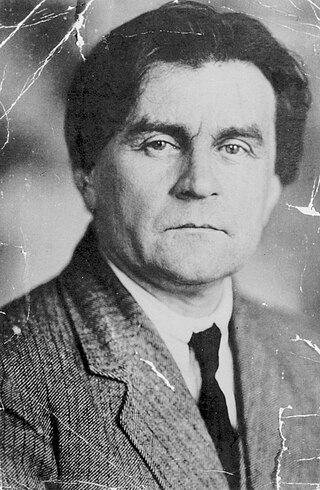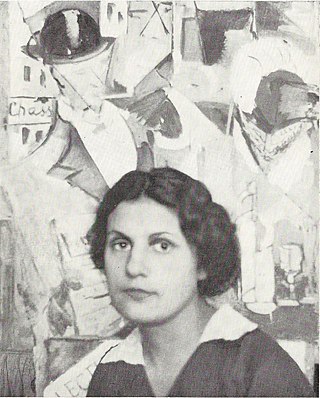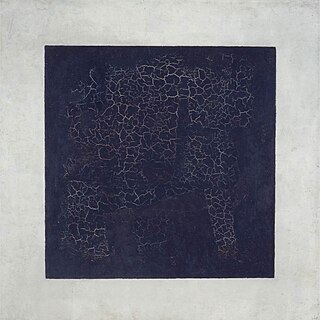Event
The exhibition itself opened on 19 December 1915, and closed on 17 January 1916. [4] Malevich now felt ready to officially announce Suprematism, and thus thirty-nine pieces of his work were on display. [2] Because Malevich and Tatlin were, due to an argument, [7] rivals [4] by the time the exhibition began, some of the artists decided to take sides. Thanks to Malevich's room planning which even Puni was unaware of, [a] the artists who supported Malevich became the victors. [7]
In total, 155 works were shown. [7] Highlights of the exhibition were Malevich's Black Square, Tatlin's Corner Counter Reliefs, and Olga Rozanova's Metronome.Black Square was seen by some visitors as being especially scandalous, because it was placed in the top corner of the room, a location where Russian Orthodox households place their icons. [2] Corner Counter Reliefs were a series of abstract sculptures. Metronome was one of Rozanova's works during the middle stages in her career; the clock can be interpreted as combining moments with the infinite. [8]
Several related publications, for example the catalogue and Malevich's From Cubism to Suprematism, accompanied the exhibition. The poster was designed by Puni. [4]

Kazimir Severinovich Malevich was a Russian avant-garde artist and art theorist, whose pioneering work and writing influenced the development of abstract art in the 20th century. He was born in Kiev, modern-day Ukraine, to an ethnic Polish family. His concept of Suprematism sought to develop a form of expression that moved as far as possible from the world of natural forms (objectivity) and subject matter in order to access "the supremacy of pure feeling" and spirituality. Active primarily in Russia, Malevich was a founder of the artists collective UNOVIS and his work has been variously associated with the Russian avant-garde and the Ukrainian avant-garde, and he was a central figure in the history of modern art in Central and Eastern Europe more broadly.

Vladimir Yevgrafovich Tatlin was a Russian and Soviet painter, architect and stage-designer. Tatlin achieved fame as the architect who designed The Monument to the Third International, more commonly known as Tatlin's Tower, which he began in 1919. With Kazimir Malevich he was one of the two most important figures in the Soviet avant-garde art movement of the 1920s, and he later became an important artist in the constructivist movement.

Suprematism is an early twentieth-century art movement focused on the fundamentals of geometry, painted in a limited range of colors. The term suprematism refers to an abstract art based upon "the supremacy of pure artistic feeling" rather than on visual depiction of objects.

Aleksandra Aleksandrovna Ekster, also known as Alexandra Exter, was a Russian and French painter and designer.

Lyubov Sergeyevna Popova was a Russian-Soviet avant-garde artist, painter and designer.

The Russian avant-garde was a large, influential wave of avant-garde modern art that flourished in the Russian Empire and the Soviet Union, approximately from 1890 to 1930—although some have placed its beginning as early as 1850 and its end as late as 1960. The term covers many separate, but inextricably related, art movements that flourished at the time; including Suprematism, Constructivism, Russian Futurism, Cubo-Futurism, Zaum, Imaginism, and Neo-primitivism. In Ukraine, many of the artists who were born, grew up or were active in what is now Belarus and Ukraine, are also classified in the Ukrainian avant-garde.

Cubo-Futurism or Kubo-Futurizm was an art movement, developed within Russian Futurism, that arose in early 20th century Russian Empire, defined by its amalgamation of the artistic elements found in Italian Futurism and French Analytical Cubism. Cubo-Futurism was the main school of painting and sculpture practiced by the Russian Futurists. In 1913, the term "Cubo-Futurism" first came to describe works from members of the poetry group "Hylaeans", as they moved away from poetic Symbolism towards Futurism and zaum, the experimental "visual and sound poetry of Kruchenykh and Khlebninkov". Later in the same year the concept and style of "Cubo-Futurism" became synonymous with the works of artists within Ukrainian and Russian post-revolutionary avant-garde circles as they interrogated non-representational art through the fragmentation and displacement of traditional forms, lines, viewpoints, colours, and textures within their pieces. The impact of Cubo-Futurism was then felt within performance art societies, with Cubo-Futurist painters and poets collaborating on theatre, cinema, and ballet pieces that aimed to break theatre conventions through the use of nonsensical zaum poetry, emphasis on improvisation, and the encouragement of audience participation.

Nina Henrichovna Genke [Hɛŋkə] or Nina Henrichovna Genke-Meller, or Nina Henrichovna Henke-Meller was a Ukrainian-Russian avant-garde artist,, designer, graphic artist and scenographer.
Verbovka or Verbovka Village Folk Center was an artisan cooperative in the village of Verbovka founded by Natalia Davidova in the Ukrainian province of Kyiv. Natalia Davidova, one of the founders and the head of the Kyiv Folk Center, was an Avant-garde artist descended from the ancient Ukrainian Hudim-Levkovichis family. The beginning of the cooperation of Natalia Davidova and Nina Genke-Meller originated not just from their family relations. They both were keen on folk art and were devoted to the idea of implementation of Avant-garde artistic principles into practice of amateur goods. In 1915 Nina Genke became a head and chief artist of Natalia's Davidova Folk Center in Verbovka village. N.Davidova involved Nina Genke in "promoting " folk thing's production in accordance with the sketchers of famous Avant-garde artists. The members of the Supremus group started to cooperate very actively. Between 1915 and 1916 many Suprematist artists such as Kazimir Malevich, Aleksandra Ekster, Nina Genke-Meller, Nadezhda Udaltsova, Liubov Popova, Olga Rozanova, Ivan Puni, Ksenia Boguslavskaya, Ivan Kliun and others worked with peasant artisans at the cooperative. In November 1915 N.Davidova, together with A.Ekster and N.Genke, arranged an Exhibition of Modern Decorative Art of the South of Russia in Lamersie Moscow Gallery. There they represented the village ladies' works who studied decorative art in Verbovka and Skoptsi's schools, as well as carpets, pillows, shawls and belts made in accordance with sketches of Popova, Malevich, Davidova, Genke, Ekster, Puni, Kliun, Pribilskaya, Yakulov, Rozanova, Vasilieva, Boguslavskaya and others. The exhibition received broad publicity in the press. In 1917 Davidova and Genke arranged the Second Exhibition of Modern Decorative Art in Moscow in Mikhailava's Saloon.

Olga Vladimirovna Rozanova was a Russian avant-garde artist painting in the styles of Suprematism, Neo-Primitivism, and Cubo-Futurism.

Ivan Albertovich Puni was a Russian avant-garde and French artist, who intensively changed his style until it went into lyric Primitivism in the direction of Pierre Bonnard and Edouard Vuillard.

Nadezhda Andreevna Udaltsova was a Russian avant-garde artist, painter and teacher.
Supremus was a group of Russian avant-garde artists led by the "father" of Suprematism, Kazimir Malevich. It has been described as the first attempt to found the Russian avant-garde movement as an artistic entity within its own historical development.

Kseniya Boguslavskaya was a Russian avant-garde artist, illustrator and scenic designer. She was the wife of the painter Ivan Puni, whom he supported very much.

Universal War is an artist's book by Aleksei Kruchenykh published in Petrograd at the beginning of 1916. Despite being produced in an edition of 100 of which only 12 are known to survive, the book has become one of the most famous examples of Russian Futurist book production, and is considered a seminal example of avant-garde art from the beginning of the twentieth century.

Ukrainian avant-garde is the avant-garde movement in Ukrainian art from the end of 1890s to the middle of the 1930s along with associated artists in sculpture, painting, literature, cinema, theater, stage design, graphics, music, and architecture. Some well-known Ukrainian avant-garde artists include: Kazimir Malevich, Alexander Archipenko, Vladimir Tatlin, Sonia Delaunay, Vasyl Yermylov, Alexander Bogomazov, Aleksandra Ekster, David Burliuk, Vadym Meller, and Anatol Petrytsky. All were closely connected to the Ukrainian cities of Kyiv, Kharkiv, Lviv, and Odesa by either birth, education, language, national traditions or identity. Since it originated when Ukraine was part of the Russian Empire, Ukrainian avant-garde has been commonly lumped by critics into the Russian avant-garde movement.

Painterly Realism of a Peasant Woman in Two Dimensions, also known as Red Square, is a 1915 painting by Kazimir Malevich. Red Square was part of Malevich's Suprematist art movement (1915-1919), which aimed to create artworks that were universally understood.

Black Square is a 1915 oil on linen canvas painting by the Ukrainian avant-garde artist and theorist Kazimir Malevich. There are four painted versions, the first of which was completed in 1915 and described by the artist as his breakthrough work and the inception of his Suprematist art movement (1915–1919).

Nina Kogan was a Russian painter known for her Suprematist works.

An Englishman in Moscow, is a 1914 oil on canvas painting by Russian avant-garde artist and art theorist Kazimir Malevich.






















